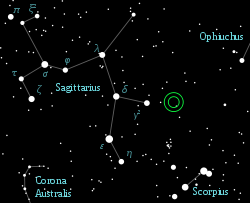- OGLE-2006-BLG-109L
-
OGLE-2006-BLG-109L Observation data
Epoch J2000.0 Equinox J2000.0Constellation Sagittarius Right ascension 17h 52m 35.0s[1] Declination –30° 05′ 16″[1] Apparent magnitude (V) 17.17 Characteristics Spectral type Unsure (probably M0V) Astrometry Distance 4,920 ± 390 ly
(1,510 ± 120 pc)Details Mass 0.51 ± 0.04 M☉ Temperature ~4,000 K Other designations EWS 2006-BUL-109Database references SIMBAD data Extrasolar Planets
Encyclopaediadata OGLE-2006-BLG-109L (where 'L' stands for lens) is a dim magnitude 17 unclassified galactic bulge star approximately 4,920 light-years away in the constellation of Sagittarius.[1]
Contents
Planetary system
In 2008, two extrasolar planets were discovered around the star using gravitational microlensing. The two planets are at a distance from their star that make them suspected analogs of Jupiter and Saturn. [2]
The star is surrounded by a planetary system consisting of at least two planets: b with a mass of 0.727 of Jupiter and c with the mass of approximately 0.271 of Jupiter. Their mass ratios, distance ratios, and equilibrium temperatures are similar to those of Jupiter and Saturn in the solar system as well as the 47 UMa system.[2]
Both planets were discovered simultaneously by gravitational microlensing in a common effort by the Optical Gravitational Lensing Experiment, microFUN, MOA, PLANET and RoboNet collaborations, as announced on 14 February 2008.
The OGLE-2006-BLG-109L system Companion
(in order from star)Mass Semimajor axis
(AU)Orbital period
(days)Eccentricity b 0.727 ± 0.06 MJ 2.3 ± 0.5 1790 ± 548 ? c 0.271 ± 0.022 MJ 4.5 ± 1 4931 ± 1750 0.15 ± 0.1 See also
References
- ^ a b c "SIMBAD query result: EWS 2006-BUL-109 -- Star". Centre de Données astronomiques de Strasbourg. http://simbad.u-strasbg.fr/simbad/sim-id?Ident=EWS+2006-BUL-109. Retrieved 2009-04-30.
- ^ a b Gaudi, B. S. et al. (2008). "Discovery of a Jupiter/Saturn Analog with Gravitational Microlensing". Science 319 (5865): 927–930. arXiv:0802.1920. Bibcode 2008Sci...319..927G. doi:10.1126/science.1151947. PMID 18276883.
External links
- Britt, Robert Roy (2008-02-14). "Solar System Like Ours Found". Space.com. http://www.space.com/scienceastronomy/080214-planets-found.html. Retrieved 2008-06-27.
- "Discovery of a Jupiter/Saturn Analog in OGLE-2006-BLG-109". MicroFUN. http://www.astronomy.ohio-state.edu/~microfun/ob06109/. Retrieved 2008-06-27.
- Dominik, Martin (2006-02-11). "The unlonely planets — Discovery of a Jupiter/Saturn analogue". ARTEMiS. http://www.artemis-uk.org/highlights/unlonely_planets/. Retrieved 2008-06-27.
- Overbye, Dennis (2008-02-14). "Scientists Find Solar System Like Ours". The New York Times. http://www.nytimes.com/2008/02/14/science/space/14cnd-planet.html?_r=1&oref=slogin. Retrieved 2008-06-27.
- Rincon, Paul (2008-04-06). "Solar System's 'look-alike' found". BBC News. http://news.bbc.co.uk/2/hi/science/nature/7333155.stm. Retrieved 2008-06-27.
- "OGLE-06-109L". Exoplanets. http://media4.obspm.fr/exoplanets/base/etoile.php?nom=OGLE-06-109L. Retrieved 2009-04-30.
Coordinates:
 17h 52m 35s, −30° 05′ 16″Categories:
17h 52m 35s, −30° 05′ 16″Categories:- Unclassified stars
- Planetary systems
- Sagittarius constellation
- Gravitational lensing
- Star stubs
Wikimedia Foundation. 2010.


